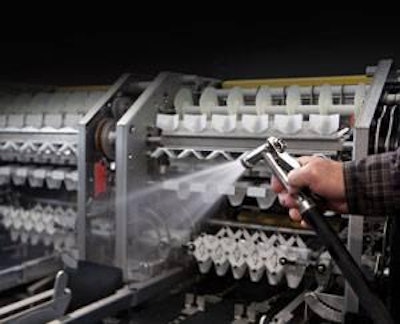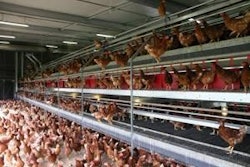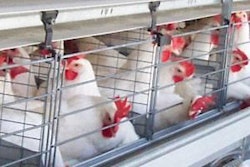
A number of new products and grading systems were unveiled at the 2011 International Poultry Exposition in Atlanta. Over the past two decades, Diamond has dominated the grader market in North America, progressively increasing the capacity of installations to 500 cases per hour and introducing refinements and innovations to improve efficiency.
The most recent IPE demonstrated a profound shift in product availability providing potential buyers with a wider choice. Since the acquisition of Diamond Automation by Moba to form Diamond Moba Americas there has been a constant infusion of European technology into their domestic subsidiary. Sanova has re-designed their Staalkat range for the North American market.
Diamond-Moba Americas
The Diamond Moba stand was dominated by the new Moba Omnia FT Grader, which is available in capacities from 85 through 500 cases per hour. Moba claims increased yield using their installations, which incorporate design features to avoid collision between eggs. This is achieved by adding more tracks and in-feed rows compared to competitors and incorporating improvements in the configuration of conveyors. Contact between eggs is limited, reducing cracks.
This may have implications for public health given the current regulatory environment. Crack detectors are positioned above eggs and most components can be removed as complete modules for ease of cleaning. Omnia FT installations incorporate a sophisticated control and logistics capability allowing pre-programming of destinations for eggs including a by-pass option to optimize output. All Omnia FT installations can be operated from either one or multiple screens which offer different user levels for control. Graders can be interfaced with plant networks and software packages are available for inventory control and accounting. The Omnia accumulator allows in-line eggs to be counted and assigned to specific houses and these eggs can be graded separately.
A conventional Moba FT installation comprises a Moba loader available with a capacity of up to 500 cph which is compatible with the Omnia FT. Correct orientation of each egg is a significant feature of the Omnia In-feed conveyor. New eggs are settled securely on rollers and there is sufficient space to allow separation to prevent machine-cracks.
In the Moba FT as displayed at the IPE and configured for the U.S. market, Kuhl washer and high efficiency dryer modules were installed, as these are compatible with the Moba installation. After residual moisture (drip) removal by an air stream, eggs are subjected to leak detection followed by drying. The leak detector is integrated into a vision system to allow early removal of eggs with damaged shells. This prevents downstream contamination of the grader.
Eggs are then subjected to crack detection and surface UV disinfection before individual weighing. A high efficiency blood detector module is available to be installed at this point in the process as an option. This is followed by optional ink-jet printing of individual eggs with no print distortion due to uniform orientation of product. Eggs which pass to the packing lanes are handled by individual flexible plastic cups which can be removed from the machine for cleaning and disinfection.
The Moba FT range incorporates trace-back capability using a pack print option. Packers can operate with aftermarket labeling and ink-jet printers including imprinting of net weight of eggs on a pack which is required in some markets. Mechanical case packers are offered for individual lanes to reduce labor requirements.
The Moba Omnia FT can be programmed to sort brown eggs based on the intensity of color and the grader can operate with both white and brown eggs simultaneously.
Optional extras include an easy lift system with a capacity of four stacks of six trays and a tray stacker with a capacity of 100 cases per hour. A palletizer for nest- run product with a capacity of 200 cases per hour and mechanical case packers ranging from 110cph to 2x 70cph are available.
Sanovo-Staalkat
Sanovo unveiled 14 new products in Atlanta with the Staalkat OptiGrader dominating the booth. The installation incorporated loading, washing, grading and packing at a rate of 600cph. Completely redesigned with significant input from U.S. engineers at the Detroit Design Group under the leadership of industry veteran Jim Nield, the OptiGrader is the first system with complete wash-down capability. The entire system is designed to occupy a smaller floor area compared to competitors’ installations and is capable of operating with both in-line and off-line feed. The configuration of the OptiGrader 600 positions the unit as either a retrofit to replace existing 300 to 400cph installations or for new installations.
The OptiGrader incorporates newly engineered loader, leak, dirt, and crack detection. A novel loader can handle paper or plastic trays. The accumulator orients eggs into 18 rows with a high fill rate. Presoaking is available by installing an optional module. The washer offers positive egg-wash motion for optimal cleaning. Washers are fitted with a heat exchanger to conserve energy and a shell screen to limit water usage.
Leak detectors can be fitted either before or after egg washing depending on the needs of the plant. A full-spectrum vision system can identify dirt particles down to a diameter of 1mm in size. The weighing scale offers an accuracy of 0.1g and incorporates automatic recalibration. The weighing system has been designed for durability and ease of cleaning.
The crack detector has no mechanical or electrical components and allows flexible selection of sensitivity. The insert transfer module moves eggs gently from 18 rows on the in-feed to the overhead 4-row conveyor with minimal damage at rates of up to 600cph. Blood detection is accurate and sensitive and the module is placed above the egg carrier chain so that it can be tilted upwards for cleaning. Intelligent software differentiates between brown and white eggs and adjusts for shell color automatically.
The Staalkat OptiGrader delivers a high proportion of eggs in point-down orientation with gentle handling. De-nesters and packers are capable of handling a wide range of packs and trays with custom designed de-nesters available for unusual packs. Staalkat OptiGraders are controlled using touch screen modules. Traceability and inventory control software packages are available.
Robotics
Mechanical handling of eggs is gaining ground in the EU which is dominated by off-line production and high labor costs. A number of robotic installations are currently operating successfully in the U.S.
Robots in contrast to mechanical units have diverse capabilities and speed and are extremely flexible and adaptable. Robots can be programmed to perform a variety of functions including multi-tasking. The application and capability of robots depends on the design of the “end-off-arm tool.” Most manufacturers of robotic installations make use of robots manufactured by a few specialist manufacturers in Japan including Motoman for Moba and Fanuc by Smart Motion Robotics, an independent after-market supplier.
A major advantage of robots is that they can interface with plant networks and control systems and are generally compatible with barcoding, contributing to traceability, machine vision for quality control and inventory management.
The Moba Robotics range includes tray palletizers with a capacity of up to 300 cases per hour and capable of stacking onto either wooden or plastic palletsin addition to replacing cardboard layer pads and dividers. Robots can be programmed to pack a wide range of different products and pallets. Moba supplies a de-palletizer that can handle 500 cases per hour, transferring trays to pre-loader belts, and robotic case packers, which are infinity more versatile than simple mechanical case packers. Their units are fabricated from stainless steel and are easily programmed by an LCD touch screen.
Sanova Technology Group market the OptiRobot system for complete automation. Their family comprises a robot tray de-palletizer for plastic trays, a tray palletizer which can accommodate pulp or plastic trays and a case palletizer.
Smart Motion Robotics based in Illinois produces a range of robotic modules that can significantly reduce labor cost and generate significant returns both in operational saving and improving yield and product quality. The SMR range for egg packing plants includes a robotic Smart Packer, which can operate up to 70cph placing cartons into two adjacent containers ranging from 15 to 24 dozen as either cardboard boxes or plastic cases.
Smart Packers are compatible with Diamond 8300, 8400 and Innova installations and Moba Selecta and Omnia packers. The SMR Smart Topper places clamps on flats which will be shrink wrapped. This unit can incorporate machine vision for QC and inventory control. The SMR Smart Stacker can palletize up to 4 different products simultaneously and is compatible with inventory and traceback systems.
The bottom line
There are obvious advantages to be derived from mechanization and robotics but at the same time there are inherent limits on the quantum of savings to be derived from capital expenditure. Currently costs of grading and packing are related to the scale of production and according to a national benchmarking system can range from 0.7 to 1.4 cents per dozen.
The trend towards larger in-line units justifies installation of high capacity machines. Requirements relating to traceback, inventory control and accounting require complete compatibility between graders and plant systems used for record keeping.
Highly efficient mechanization offering improved yield and lower operating costs has the potential to contribute to enhanced profitability depending on cost and reliability. Many of the products demonstrated at the 2011 IPE reflect a fusion of EU and U.S technology, which is beneficial to our industry.


















